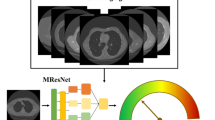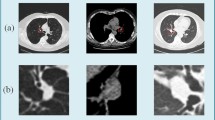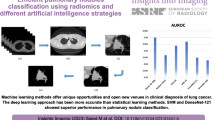Abstract
Lung cancer is one of the leading causes of death worldwide and early detection is crucial to reduce the mortality. A reliable computer-aided diagnosis (CAD) system can help facilitate early detection of malignant nodules. Although existing methods provide adequate classification accuracy, there is still room for further improvement. This study is dedicated to investigating a new CAD scheme for predicting the malignant likelihood of lung nodules in computed tomography (CT) images in light of a deep learning strategy. Conceived from the residual learning and selective kernel, we investigated an efficient residual selective kernel (RSK) block to handle the diversity of lung nodules with various shapes and obscure structures. Founded on this RSK block, we established a multiview RSK network (MRSKNet), to which three anatomical planes in the axial, coronal, and sagittal directions were fed. To reinforce the classification efficiency, seven handcrafted texture features with a filter-like computation strategy were explored, among which the homogeneity (HOM) feature maps are combined with the corresponding intensity CT images for concatenation input, leading to an improved network architecture. Evaluated on the public benchmark Lung Image Database Consortium and Image Database Resource Initiative (LIDC-IDRI) challenge database with ten-fold cross validation of binary classification, our experimental results indicated high area under receiver operating characteristic (AUC) and accuracy scores. A better compromise between recall and specificity was struck using the suggested concatenation strategy comparing to many state-of-the-art approaches. The proposed pulmonary nodule classification framework exhibited great efficacy and achieved a higher AUC of 0.9711. The association of handcrafted texture features with deep learning models is promising in advancing the classification performance. The developed pulmonary nodule CAD network architecture is of potential in facilitating the diagnosis of lung cancer for further image processing applications.







Similar content being viewed by others
Data Availability
The inclusion of datasets is future work, which will be collected from any possible public domain.
References
Ferlay J, et al.: Cancer statistics for the year 2020: An overview. International Journal of Cancer 149:778-789, 2021
Siegel RL, Miller KD, Fuchs HE, Jemal A: Cancer Statistics, 2021. CA: A Cancer Journal for Clinicians 71:7–33, 2021
Lu S, et al.: Iterative reconstruction of low-dose CT based on differential sparse. Biomedical Signal Processing and Control 79:104204, 2023
Jennifer S, Sharmila S: A Neutrosophic Set Approach on Chest X-rays for Automatic Lung Infection Detection. Information Technology and Control 52:37-52, 2023
Poap D, Wozniak M, Damaševičius R, Wei W: Chest radiographs segmentation by the use of nature-inspired algorithm for lung disease detection. Proc. 2018 IEEE Symposium Series on Computational Intelligence (SSCI): City, 18–21 Nov. 2018
Jaszcz A, Połap D, Damaševičius R: Lung X-Ray Image Segmentation Using Heuristic Red Fox Optimization Algorithm. Scientific Programming 2022:4494139, 2022
Ma H, et al.: Automatic pulmonary ground-glass opacity nodules detection and classification based on 3D neural network. Medical Physics 49:2555-2569, 2022
Thakur SK, Singh DP, Choudhary J: Lung cancer identification: a review on detection and classification. Cancer and Metastasis Reviews 39:989-998, 2020
Zhang G, Yang Z, Gong L, Jiang S, Wang L, Zhang H: Classification of lung nodules based on CT images using squeeze-and-excitation network and aggregated residual transformations. La radiologia medica 125:374-383, 2020
Saba T: Automated lung nodule detection and classification based on multiple classifiers voting. Microscopy Research and Technique 82:1601-1609, 2019
Muzammil M, Ali I, Haq IU, Khaliq AA, Abdullah S: Pulmonary Nodule Classification Using Feature and Ensemble Learning-Based Fusion Techniques. IEEE Access 9:113415-113427, 2021
Farag AA, Ali A, Elshazly S, Farag AA: Feature fusion for lung nodule classification. International Journal of Computer Assisted Radiology and Surgery 12:1809-1818, 2017
Chen S, et al.: Automatic Scoring of Multiple Semantic Attributes With Multi-Task Feature Leverage: A Study on Pulmonary Nodules in CT Images. IEEE Transactions on Medical Imaging 36:802-814, 2017
Wei G, Cao H, Ma H, Qi S, Qian W, Ma Z: Content-based image retrieval for Lung Nodule Classification Using Texture Features and Learned Distance Metric. Journal of Medical Systems 42:13, 2017
Zhang F, et al.: Lung Nodule Classification With Multilevel Patch-Based Context Analysis. IEEE Transactions on Biomedical Engineering 61:1155-1166, 2014
Mao K, Deng Z: Lung Nodule Image Classification Based on Local Difference Pattern and Combined Classifier. Computational and Mathematical Methods in Medicine 2016:1091279, 2016
Cicero M, et al.: Training and Validating a Deep Convolutional Neural Network for Computer-Aided Detection and Classification of Abnormalities on Frontal Chest Radiographs. Investigative Radiology 52:281-287, 2017
Khan MA, et al.: VGG19 Network Assisted Joint Segmentation and Classification of Lung Nodules in CT Images. Diagnostics 11:2208, 2021
He K, Zhang X, Ren S, Sun J: Deep residual learning for image recognition. Proc. Proceedings of the IEEE conference on computer vision and pattern recognition: City
Li X, Wang W, Hu X, Yang J: Selective kernel networks. Proc. Proceedings of the IEEE/CVF Conference on Computer Vision and Pattern Recognition: City
Liu M, et al.: Three-Dimensional Modeling of Heart Soft Tissue Motion. Applied Sciences 13:2493, 2023
Liu X, Yang L, Chen J, Yu S, Li K: Region-to-boundary deep learning model with multi-scale feature fusion for medical image segmentation. Biomedical Signal Processing and Control 71:103165, 2022
Uthoff J, et al.: Machine learning approach for distinguishing malignant and benign lung nodules utilizing standardized perinodular parenchymal features from CT. Medical Physics 46:3207-3216, 2019
Zheng B, Yang D, Zhu Y, Liu Y, Hu J, Bai C: 3D gray density coding feature for benign-malignant pulmonary nodule classification on chest CT. Medical Physics 48:7826-7836, 2021
Dhara AK, Mukhopadhyay S, Dutta A, Garg M, Khandelwal N: A Combination of Shape and Texture Features for Classification of Pulmonary Nodules in Lung CT Images. Journal of Digital Imaging 29:466-475, 2016
Madero Orozco H, Vergara Villegas OO, Cruz Sánchez VG, Ochoa Domínguez HdJ, Nandayapa Alfaro MdJ: Automated system for lung nodules classification based on wavelet feature descriptor and support vector machine. BioMedical Engineering OnLine 14:9, 2015
de Sousa Costa RW, da Silva GLF, de Carvalho Filho AO, Silva AC, de Paiva AC, Gattass M: Classification of malignant and benign lung nodules using taxonomic diversity index and phylogenetic distance. Med Biol Eng Comput 56:2125-2136, 2018
Firmino M, Angelo G, Morais H, Dantas MR, Valentim R: Computer-aided detection (CADe) and diagnosis (CADx) system for lung cancer with likelihood of malignancy. BioMedical Engineering OnLine 15:2, 2016
de Carvalho Filho AO, Silva AC, Cardoso de Paiva A, Nunes RA, Gattass M: Computer-Aided Diagnosis of Lung Nodules in Computed Tomography by Using Phylogenetic Diversity, Genetic Algorithm, and SVM. Journal of Digital Imaging 30:812-822, 2017
Sasidhar B, Geetha G, Khodanpur B, Babu DR: Automatic classification of lung nodules into benign or malignant using SVM classifier. Proc. Proceedings of the 5th International Conference on Frontiers in Intelligent Computing: Theory and Applications: City
Li X-X, Li B, Tian L-F, Zhang L: Automatic benign and malignant classification of pulmonary nodules in thoracic computed tomography based on RF algorithm. IET Image Processing 12:1253-1264, 2018
Wu W, Hu H, Gong J, Li X, Huang G, Nie S: Malignant-benign classification of pulmonary nodules based on random forest aided by clustering analysis. Physics in Medicine & Biology 64:035017, 2019
Rodrigues MB, et al.: Health of things algorithms for malignancy level classification of lung nodules6:18592–18601, 2018
Lee MC, et al.: Computer-aided diagnosis of pulmonary nodules using a two-step approach for feature selection and classifier ensemble construction. Artificial Intelligence in Medicine 50:43-53, 2010
Farahani FV, Ahmadi A, Zarandi MHF: Hybrid intelligent approach for diagnosis of the lung nodule from CT images using spatial kernelized fuzzy c-means and ensemble learning. Mathematics and Computers in Simulation 149:48-68, 2018
Suganyadevi S, Seethalakshmi V, Balasamy K: A review on deep learning in medical image analysis. International Journal of Multimedia Information Retrieval 11:19-38, 2022
Krizhevsky A, Sutskever I, Hinton GE: ImageNet classification with deep convolutional neural networks, 2012
Simonyan K, Zisserman A: Very deep convolutional networks for large-scale image recognition. arXiv:14091556, 2014
Szegedy C, et al.: Going deeper with convolutions. Proc. 2015 IEEE Conference on Computer Vision and Pattern Recognition (CVPR): City
Li R, Xiao C, Huang Y, Hassan H, Huang B: Deep Learning Applications in Computed Tomography Images for Pulmonary Nodule Detection and Diagnosis: A Review. Diagnostics 12:298, 2022
Murugesan M, Kaliannan K, Balraj S, Singaram K, Kaliannan T, Albert JR: A Hybrid deep learning model for effective segmentation and classification of lung nodules from CT images. Journal of Intelligent & Fuzzy Systems 42:2667-2679, 2022
Lu S, et al.: Soft Tissue Feature Tracking Based on Deep Matching Network. Computer Modeling in Engineering \& Sciences 136:363--379, 2023
Dai Y, Yan S, Zheng B, Song C: Incorporating automatically learned pulmonary nodule attributes into a convolutional neural network to improve accuracy of benign-malignant nodule classification. Physics in Medicine & Biology 63:245004, 2018
Ren Y, et al.: A manifold learning regularization approach to enhance 3D CT image-based lung nodule classification. International Journal of Computer Assisted Radiology and Surgery 15:287-295, 2020
Xie S, Girshick R, Dollár P, Tu Z, He K: Aggregated Residual Transformations for Deep Neural Networks. Proc. 2017 IEEE Conference on Computer Vision and Pattern Recognition (CVPR): City, 21–26 July 2017
Liu H, et al.: Multi-model Ensemble Learning Architecture Based on 3D CNN for Lung Nodule Malignancy Suspiciousness Classification. Journal of Digital Imaging 33:1242-1256, 2020
Szegedy C, Ioffe S, Vanhoucke V, Alemi AA: Inception-v4, Inception-ResNet and the Impact of Residual Connections on Learning. Proc. AAAI Conference on Artificial Intelligence: City
Zuo W, Zhou F, He Y, Li X: Automatic classification of lung nodule candidates based on a novel 3D convolution network and knowledge transferred from a 2D network. Medical Physics 46:5499-5513, 2019
Lyu J, Bi X, Ling SH: Multi-Level Cross Residual Network for Lung Nodule Classification. Sensors 20:2837, 2020
An Y, Hu T, Wang J, Lyu J, Banerjee S, Ling SH: Lung Nodule Classification using A Novel Two-stage Convolutional Neural Networks Structure’. Proc. 2019 41st Annual International Conference of the IEEE Engineering in Medicine and Biology Society (EMBC): City
Su H, Maji S, Kalogerakis E, Learned-Miller E: Multi-view convolutional neural networks for 3d shape recognition. Proc. Proceedings of the IEEE international conference on computer vision: City
Nibali A, He Z, Wollersheim D: Pulmonary nodule classification with deep residual networks. International Journal of Computer Assisted Radiology and Surgery 12:1799-1808, 2017
Sahu P, Yu D, Dasari M, Hou F, Qin H: A Lightweight Multi-Section CNN for Lung Nodule Classification and Malignancy Estimation. IEEE Journal of Biomedical and Health Informatics 23:960-968, 2019
Al-Shabi M, Lee HK, Tan M: Gated-Dilated Networks for Lung Nodule Classification in CT Scans. IEEE Access 7:178827-178838, 2019
Al-Shabi M, Lan BL, Chan WY, Ng K-H, Tan M: Lung nodule classification using deep Local–Global networks. International Journal of Computer Assisted Radiology and Surgery 14:1815-1819, 2019
Xie Y, et al.: Knowledge-based Collaborative Deep Learning for Benign-Malignant Lung Nodule Classification on Chest CT. IEEE Transactions on Medical Imaging 38:991-1004, 2019
Xie Y, Zhang J, Xia Y: Semi-supervised adversarial model for benign–malignant lung nodule classification on chest CT. Medical Image Analysis 57:237-248, 2019
Wang C, Elazab A, Wu J, Hu Q: Lung nodule classification using deep feature fusion in chest radiography. Computerized Medical Imaging and Graphics 57:10-18, 2017
Zhu W, Liu C, Fan W, Xie X: Deeplung: Deep 3d dual path nets for automated pulmonary nodule detection and classification. Proc. 2018 IEEE Winter Conference on Applications of Computer Vision (WACV): City
Friedman JH: Greedy Function Approximation: A Gradient Boosting Machine. The Annals of Statistics 29:1189-1232, 2001
Zhang G, Yang Z, Gong L, Jiang S, Wang L: Classification of benign and malignant lung nodules from CT images based on hybrid features. Physics in Medicine & Biology 64:125011, 2019
Chen Y, Li J, Xiao H, Jin X, Yan S, Feng J: Dual path networks, Long Beach, California, USA: Curran Associates Inc., 2017
Huang G, Liu Z, Maaten LVD, Weinberger KQ: Densely Connected Convolutional Networks. Proc. 2017 IEEE Conference on Computer Vision and Pattern Recognition (CVPR): City, 21–26 July 2017
Chang H, Hsieh C: Brain segmentation in MR images using a texture-based classifier associated with mathematical morphology. Proc. 2017 39th Annual International Conference of the IEEE Engineering in Medicine and Biology Society (EMBC): City
Haralick RM, Shanmugam K, Dinstein I: Textural Features for Image Classification. IEEE Transactions on Systems, Man, and Cybernetics SMC-3:610–621, 1973
Galloway MM: Texture analysis using gray level run lengths. Computer Graphics and Image Processing 4:172-179, 1975
Tamura H, Mori S, Yamawaki T: Textural Features Corresponding to Visual Perception. IEEE Transactions on Systems, Man, and Cybernetics 8:460-473, 1978
Armato III SG, et al.: The Lung Image Database Consortium (LIDC) and Image Database Resource Initiative (IDRI): A Completed Reference Database of Lung Nodules on CT Scans. Medical Physics 38:915-931, 2011
Clark K, et al.: The Cancer Imaging Archive (TCIA): Maintaining and Operating a Public Information Repository. Journal of Digital Imaging 26:1045-1057, 2013
Reeves AP, Biancardi AM: The Lung Image Database Consortium (LIDC) Nodule Size Report. Release: 2011–10–27–2 At: /lidc/, 2011
Funding
This work was supported by the Ministry of Science and Technology of Taiwan under Grant No. MOST 108-2221-E-002-080-MY3.
Author information
Authors and Affiliations
Corresponding author
Ethics declarations
Ethics Approval
This paper does not contain any studies with human participants or animals performed by any of the authors.
Consent to Participate
This paper does not contain patient data.
Competing Interest
The authors declare no competing interests.
Additional information
Publisher's Note
Springer Nature remains neutral with regard to jurisdictional claims in published maps and institutional affiliations.
Rights and permissions
Springer Nature or its licensor (e.g. a society or other partner) holds exclusive rights to this article under a publishing agreement with the author(s) or other rightsholder(s); author self-archiving of the accepted manuscript version of this article is solely governed by the terms of such publishing agreement and applicable law.
About this article
Cite this article
Chang, HH., Wu, CZ. & Gallogly, A.H. Pulmonary Nodule Classification Using a Multiview Residual Selective Kernel Network. J Digit Imaging. Inform. med. 37, 347–362 (2024). https://doi.org/10.1007/s10278-023-00928-4
Received:
Revised:
Accepted:
Published:
Issue Date:
DOI: https://doi.org/10.1007/s10278-023-00928-4




